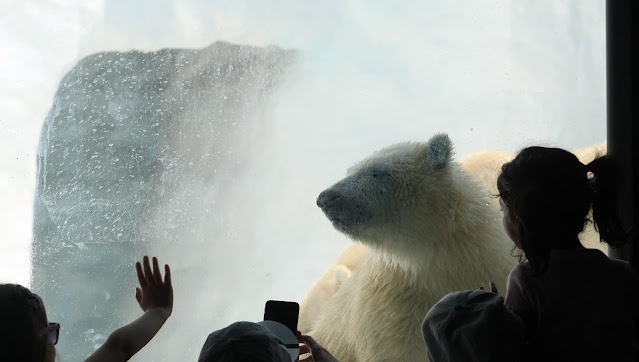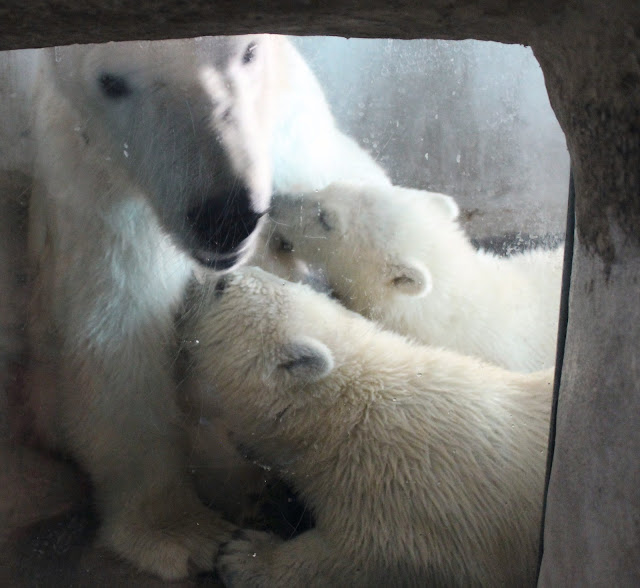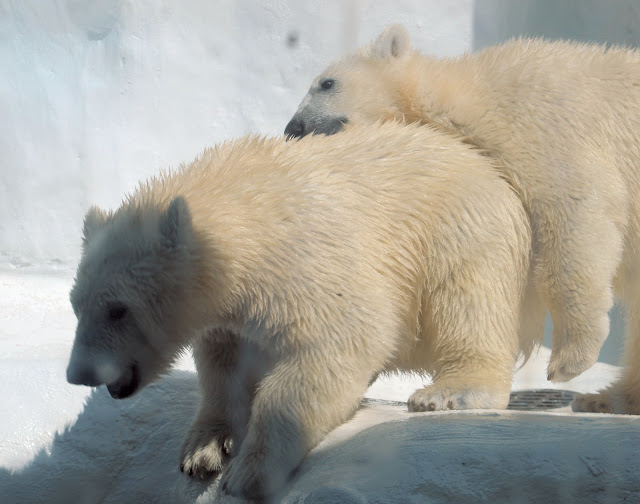 |
Kiska in front, Koluk sleeping in back.
I took these photos about two weeks before Koluk died. |
Some people may wonder how polar bears do in a desert environment as in the ABQ Biopark in Albuquerque NM. Twin brothers Kiska and Koluk have lived there for a quarter of a century in good spirits most of the time.
 |
| Koluk standing atop the basin, Kiska in front. |
Sad to say, Koluk died of liver and kidney failure, common illnesses in polar bears of advanced age, a little more than a week after my visit. He was 26 years old. His twin brother Kiska carries on by himself now, and seems to be in robust health.
I visited the brothers last summer, and they were both active and playful. This visit, Kiska was his old self, but Koluk was barely there, coming out rarely, never swimming, very slow of movements. I could tell he was not doing well. His twin brother Kiska knew this as well, I am sure, and left his ailing brother alone.
 |
| Kiska and Koluk having breakfast together in the cave area. |
It seemed to me that Kiska had already moved on, that he knew his brother was dying and it was best to just let him be alone. The boys usually nibbled on their breakfast together down in the cave area, the Koluk went inside while Kiska roamed around the enclosure, doing his own thing. Kiska carried on with the business of being a polar bear, swimming and playing and pacing and sleeping. Koluk would occasionally come out into the lower area, and a few times he climbed to the upper area, then dozed on his favorite rock, while Kiska roam and played.
On my last day there of my four days at the zoo, I finally found a polar bear keeper and conveyed my worries about Koluk. Yes, he was slowing down, I was told, but I was assured he should be fine again. By the end of the week, the vets had done an exam of Koluk and found liver and kidney failure. It progressed rapidly and he was gone a week later.
 |
| Kiska front, Koluk back |
 |
| Koluk resting his chin on a rock. |
And now it is just Kiska. |
| Kiska killing the barrel. |
If you look hard enough, over by the wolves, you can find the old small outmoded polar bear enclosure which was been abandoned when the new habitat was built a quarter of a century ago, but is still there behind a fence. The newer enclosure was finished just before Kiska and Koluk arrived in 1997. The bears have three waterfalls, a lower pool and a deep diving pool, a slide with running water (which they have been known to climb up), and air conditioned bedrooms. There is also an inside pool.
To address Kiska's pacing problem, some changes were made recently. Kiska had gotten into the habit of pacing atop the rim of the upper pool, repeating the same seven steps in one direction, then reversing and doing seven steps back. Always in the same spot. Some polar bears pace, some swim laps repetitively. It is a calming mechanism, and has been shown to lower their cortisol levels.
 |
| Kiska in his pacing routine, which is now less frequent than it was. |
A plan was devised to give the polar bear brothers access to more inside space which had previously been closed off to them, and when Kiska has been pacing for a bit, a keeper will call him inside to disrupt the pattern. When he returns to the outside, Kiska usually finds something else to do. These measures have reduced his pacing considerably, but he will probably always want to do his little dance. He sometimes will stop pacing on his own to take a dip in the pool, or play with the many toys.
Treat time, which is when the keeper brings in a bucket of rainbow trout to throw, will vary so Kiska won't be as likely to anticipate it. Anything to break up the usual routine. Sometimes they get salmon, but their favorite is squid.
 |
| Koluk with his fish. Although he was always an avid swimmer, Koluk wanted the fish thrown to him on dry land so he didn't have to get his paws wet, during his illness in his last few weeks. |
Koluk was diagnosed with a heart murmur in 2019 and after that, the keepers made sure Koluk got his fish without diving for it. In his last few weeks, Koluk didn't want to put his paws in the water, even to get fish.
Kiska is still quite the diver.
 |
| Kiska dives for the trout. |
The zoo is in the middle of some major building projects right now, the Australian area and the new elephant habitat, but there is also a tentative plan down the road to improve the polar bear enclosure.
Since the lions Kenya and Dixie left for Abilene in March of 2023, that grassy habitat adjoining the polar bear home has been empty. It was too small for lions, but it would be quite easy to attach it to Inukshuk Bay, which is what the polar bear area is called. I don't know if the death of Koluk will affect this, or how solid is this plan.
 |
| Welcome to Inukshuk Bay. |
Connecting to the old lion enclosure would greatly improve the polar bear habitat, giving the bear (or bears) more variety, a much bigger area, and grass. From talking to the docents, I got the idea that when both these bears are gone, the zoo plans to stop keeping polar bears, but this clever change might bring it up to current standards. |
| The old lion habitat is fronted by a moat. |
 |
| Edge of polar bear habit (left) adjoins the old lion habitat. |
 |
The edge of the old lion habit, empty now.
You can see the walls of the polar bear habitat behind. |
Of course with the death of Koluk, we now have only 39 polar bears in US zoos, so it is not a sure bet that polar bears will be available. On the bright side, Crystal and Nuka's twin boys in Toledo were added to the population, and they are only six months old.
 |
| Kiska having fun with a big barrel. |
 |
| Kiska is pretty playful for a 26 year old bear. |
I did see Kiska playing with a big barrel for a long time. Even though he is 26, he is very playful.
 |
Kiska doesn't swim for long periods,
but he often takes quick dips in the chilled deep dive pool.
There is a lovely huge underwater viewing window. |
He also likes to take short swims in the deep dive pool, which gives visitors a chance to see a polar bear underwater up close.
 |
| Kiska in the swim. |
 |
A wider view of the polar bear enclosure, with a lower pool and an upper deep dive pool, a waterslide, and three waterfalls.
That is Koluk on the top. |
Kiska and Koluk were born in Salt Lake City in November of 1996 to Chinook and Andy. Their half brother Denali lives in Sapporo, Japan and is the father of eight cubs. Anana (mother of Buffalo Luna) of Brookfield, Cincinnati, Buffalo and Detroit was also their younger sister, and they had a half sister, Aurora of Rochester, mother of Lee (father of Kulu), Haley, Peyton and Anoki.
And here are their cousins around the world! Their grandfather was Bruno of Memphis, who was also the father of CW and Elvis who went to Europe. Elvis was the father of the famous Chocolate Bears, or Hybrid bears, Tips and Taps. CW was the mother of Nuuk-Nordman, father of Freedom; Ilka, mother of Danish Siku, Nanu and Nuno; Manasse, father of Ranzo and Sisu; Baffin of Japan (mother of Momo-Peach), and the late Yukihime of Japan. So their cousins include Ranzo of Vienna Austria, Sisu of YWP in the UK, Kulu of Como Zoo Minnesota, Sprinter of Hanover Germany, Sesi of Mulhouse France, Taiko-Siku of La Fleche in France, Akiak of Amneville France, cubs Kaja and Skadi of Rostock Germany, and Sura of Ouwehands the Netherlands. Not to mention all of Denali's cubs and grandchildren in Japan.
I will be watching to see what the future holds for the polar bears in the ABQ Biopark. Kiska seems to be in good health, and may live for quite some time. Maybe the expansion plan involving the lion habitat will happen. Even though some may think the desert is not a good home for these bears, Kiska and Koluk have thrived here for 25 years. I hope Kiska continues to be well and enjoy his desert paradise.















































